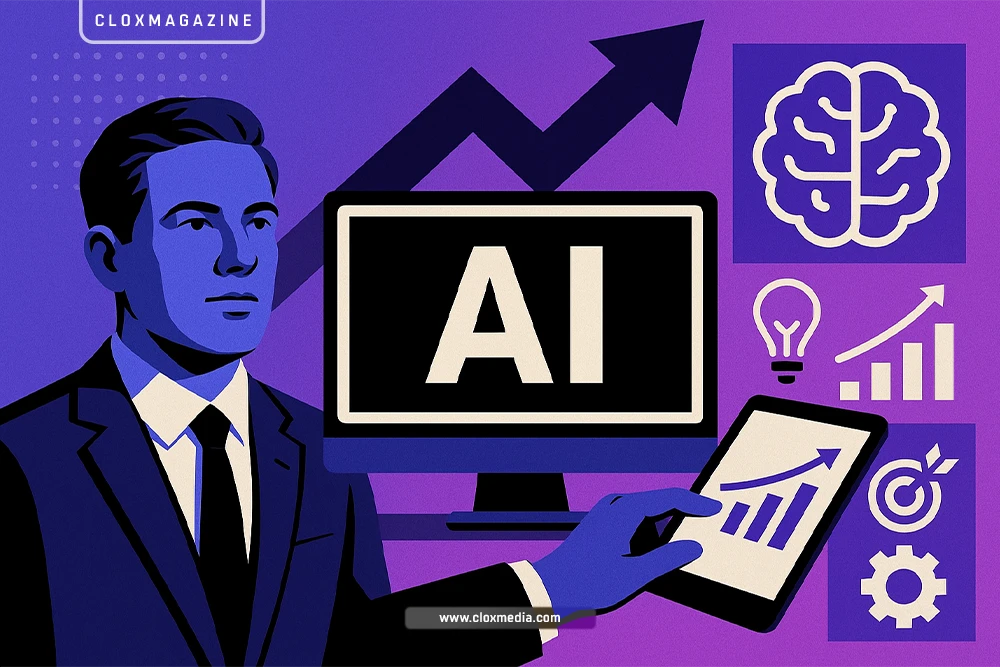AI isn’t just a matter of conversation now, but it’s becoming a central part of thriving businesses in different industries. Companies that are integrating artificial intelligence in their workflow are seeing a dramatic optimizations in customer care services and operating costs as they near 2025. However, with many application and approach options available, how do you decide which will be the best for your unique business requirements? At CLOXLABS, we have pinpointed the most crucial methods organizations are utilizing artificial intelligence to design competitive strategies for sustained productivity in the future.
NOTE: This is an official Research Paper by “CLOXLABS“
1. Automating Routine Tasks to Unleash Human Potential
Perhaps the most immediately valuable application of AI in business is automation-but not in the way many people fear. Rather than replacing workers, AI excels at eliminating the mundane, repetitive tasks that drain employee energy and creativity.
According to research from McKinsey, as of early 2024, 72% of organizations have adopted AI in at least one business function. This shift isn’t about cutting headcount; it’s about maximizing human potential. When AI handles data entry, report generation, and other administrative burdens, your team members can focus on creative problem-solving, strategic thinking, and meaningful customer interactions-the work that humans do best.
A 2024 survey of financial executives conducted by Duke University found that 40% of businesses used AI tools to automate employee tasks in the previous year, while 54% planned to expand these initiatives. This trend cuts across industries, from accounting firms automating tax preparation to healthcare providers streamlining patient intake processes.
The key is identifying the repetitive tasks specific to your business that, when automated, would free up significant time for higher-value work. This might include email sorting, calendar management, basic customer inquiries, or data processing-any task that follows predictable patterns.
2. Enhancing Decision-Making with AI-Powered Business Intelligence
Traditional business intelligence focused primarily on historical reporting-telling you what happened in the past. AI-driven business intelligence takes things several steps further by enabling predictive analytics, real-time insights, and autonomous recommendation systems.
This evolution means executives and managers can make decisions based not just on what happened yesterday, but on what’s likely to happen tomorrow. AI systems can analyze vast datasets to identify patterns humans might miss, forecasting market trends, customer behaviors, and potential risks with remarkable accuracy.
For example, a supply chain function can use AI algorithms to predict future inventory needs and optimize product delivery timing. Retail businesses can forecast seasonal demand fluctuations, while financial services firms can identify potential fraud patterns before they result in losses.
The competitive advantage here is significant: while your competitors react to market changes, your AI-enhanced business intelligence allows you to anticipate and prepare for them in advance. This proactive stance becomes a sustainable advantage that compounds over time as your AI systems learn and improve.
3. Revolutionizing Customer Experience Through Personalization
Today’s consumers expect personalized experiences tailored to their specific needs and preferences. AI makes this level of customization possible at scale, allowing even small businesses to deliver the personalized touch that was once only possible for luxury brands with dedicated customer service teams.
Using large language models (LLMs), businesses can deliver tailored experiences and targeted advertisements to customers. The applications range from e-commerce sites that recommend products based on browsing history to content platforms that curate personalized feeds.
Companies like Spotify and YouTube have mastered this approach, delivering curated content that aligns with user interests. But the same principles apply across industries. A B2B software company might use AI to personalize user dashboards based on role and usage patterns, while a healthcare provider could customize patient education materials based on individual health profiles.
The beauty of AI-driven personalization is that it improves over time. As these systems gather more data about customer preferences and behaviors, their recommendations become increasingly accurate, creating a continuous improvement cycle that deepens customer relationships and loyalty.
4. Transforming Customer Service with Conversational AI
Customer service has undergone perhaps the most visible AI transformation. Conversational AI technologies, including chatbots and virtual assistants, now handle millions of customer interactions daily across industries.
These AI systems use natural language processing (NLP) and sentiment analysis to understand not just what customers are saying but their emotional tone as well. This allows them to respond appropriately and escalate to human agents when necessary.
McDonald’s provides an excellent example of this approach in action. The company is building AI solutions for customer care with IBM watsonx AI technology to accelerate the development of its automated order-taking technology across markets and languages. This not only improves efficiency but ensures consistent service quality.
The most effective implementation of conversational AI doesn’t aim to replace human customer service entirely. Instead, it handles routine inquiries and issues, allowing human agents to focus on complex problems that require empathy and creative problem-solving. This hybrid approach delivers the best of both worlds: immediate responses to simple questions and thoughtful human interaction for complicated situations.
5. Unlocking Insights from Unstructured Data
Most businesses today are drowning in data-but much of it remains untapped because it exists in unstructured formats like emails, social media posts, customer reviews, and support tickets. Traditional analytics tools struggle with this type of information, but AI excels at extracting meaningful insights from it.
Natural language processing technologies can analyze customer feedback across multiple channels to identify emerging issues or opportunities. Computer vision can extract data from images and videos. These capabilities allow businesses to tap into valuable information sources that were previously inaccessible.
For example, a hospitality business might use AI to analyze thousands of online reviews to identify specific amenities or services that consistently delight or disappoint guests. A product manufacturer could analyze warranty claims and service calls to spot potential design flaws before they become widespread problems.
The competitive advantage here lies in seeing patterns that competitors miss-identifying emerging customer needs or pain points before they become obvious to the market at large.
6. Optimizing Database Management and Query Processing
For data-intensive businesses, AI offers tremendous advantages in database management and query optimization. A recent paper presents a novel AI-powered framework designed to streamline database management and query optimization for PostgreSQL systems.
This approach enables non-technical users to extract meaningful insights from complex datasets through natural language to SQL translation, query execution and analysis, and insight generation. The system reduces dependency on specialized database administrators while improving productivity and reducing query latency.
The business impact is significant: employees throughout your organization can access the data they need to make informed decisions without advanced technical skills. This democratization of data access removes bottlenecks and accelerates decision-making across departments.
7. Enhancing Marketing and Content Creation
AI has transformed marketing from an art based largely on intuition to a science driven by data and predictive analytics. From content creation to campaign optimization, AI tools help marketers work smarter and more effectively.
For content creators, AI assists in generating ideas, optimizing headlines for engagement, and analyzing which topics resonate most with specific audience segments. The technology helps identify trending topics and can even suggest visual elements that will capture attention in crowded feeds like Google Discover.
Speaking of Google Discover, optimizing for this platform requires understanding its unique characteristics. Unlike traditional search, Discover surfaces content based on user interests without requiring a specific query. Content with compelling visuals, emotional appeal, and freshness tends to perform well in this environment.
For marketers, AI also enables sophisticated audience segmentation, campaign optimization, and attribution modeling. These capabilities allow for more precise targeting and better measurement of marketing effectiveness, leading to higher ROI on marketing investments.
8. Strengthening Cybersecurity Defenses
As businesses become increasingly digital, cybersecurity threats grow more sophisticated and dangerous. AI provides powerful tools for detecting and responding to these threats in real-time.
AI security systems can establish baseline patterns of normal network activity and then identify anomalies that might indicate a breach or attack. They can analyze thousands of security events per second-far more than any human team could evaluate-and prioritize alerts based on potential risk.
These systems improve over time, learning from each threat encounter to become more accurate in distinguishing between false alarms and genuine security issues. This continuous improvement is crucial in the constantly evolving landscape of cybersecurity threats.
For businesses of all sizes, AI-powered security represents not just protection against data breaches and financial losses, but also a safeguard for customer trust and brand reputation-assets that can take years to build but only moments to damage.
9. Streamlining Recruitment and HR Processes
Human resources departments face the challenging task of finding and retaining the right talent in competitive markets. AI helps streamline these processes, from initial recruitment through ongoing employee development.
AI recruiting tools can scan thousands of resumes to identify promising candidates, match job requirements with applicant skills, and even help write job descriptions that attract diverse talent pools. Once employees are onboarded, AI systems can help personalize training programs, identify skill gaps, and predict which employees might be at risk of leaving.
These capabilities allow HR professionals to focus less on administrative tasks and more on the human elements of their role-building relationships, developing culture, and supporting employee growth and well-being.
For businesses, the advantage is clear: better talent acquisition and retention in less time, with lower administrative costs. In today’s competitive labor markets, this efficiency can be the difference between securing top talent and missing out.
10. Enabling Predictive Maintenance and Operations Optimization
For businesses with physical assets or complex operations, AI offers tremendous value through predictive maintenance and operations optimization. Rather than fixing equipment after it breaks or responding to operational problems after they occur, AI allows for anticipatory approaches that prevent issues before they impact the business.
Sensors on manufacturing equipment can collect data on temperature, vibration, and other variables that AI systems analyze to predict potential failures. Similar approaches work for vehicle fleets, HVAC systems, and other physical assets. This predictive capability reduces downtime, extends equipment life, and minimizes emergency repair costs.
In operations, AI can optimize complex processes by simulating different scenarios and identifying the most efficient approaches. From factory floor layouts to delivery routes, these optimizations often yield significant cost savings and productivity improvements.
The cumulative effect of these continuous optimizations creates a substantial competitive advantage over time, as efficiency gains compound and operational disruptions become increasingly rare.
At The End: The Human-AI Partnership for Business Success
The most successful AI implementations in business aren’t about replacing humans with machines-they’re about creating partnerships that leverage the strengths of both. AI excels at processing vast amounts of data, identifying patterns, and handling repetitive tasks with consistency and precision. Humans bring creativity, emotional intelligence, ethical judgment, and contextual understanding.
When these capabilities work together, businesses can achieve outcomes that neither humans nor AI could accomplish alone. Employees become more productive and engaged as AI handles routine work, allowing them to focus on challenging and meaningful tasks. Customers receive more personalized service, faster responses, and more innovative products. Operations become more efficient, resilient, and adaptable to change.
The businesses that will thrive in the coming years won’t be those that simply adopt AI technologies-they’ll be the ones that thoughtfully integrate these tools into their operations in ways that augment human capabilities rather than replacing them. They’ll create cultures where employees view AI as a partner rather than a threat, and they’ll continually experiment with new applications that create value for customers and stakeholders.
The AI revolution in business is just beginning, but one thing is already clear: the future belongs to organizations that master the art and science of human-AI collaboration.
CLOXMAGAZINE, founded by CLOXMEDIA in the UK in 2022, is dedicated to empowering tech developers through comprehensive coverage of technology and AI. It delivers authoritative news, industry analysis, and practical insights on emerging tools, trends, and breakthroughs, keeping its readers at the forefront of innovation.









